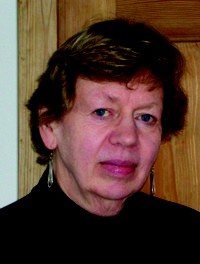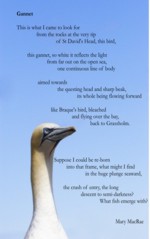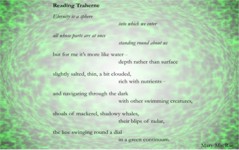

Mary MacRae was a poet of the lyric moment in all its facets: now turning to the past, the elsewhere, the ‘world-when-I’m gone’, now swinging back to the axis of the here and now, her lyric longing intensifying into praise and prayer. With an instinct for transcendence but also for accommodation, she let her poems alight – ‘as birds do’ – however briefly, before they flew again, leaving their after-image in mind and ear.
Drawn to the natural world, Mary’s desire to look and see was so intense, her delight so child-like, that she could lose herself entirely, allow the self to step aside, the thing to speak for itself. Fearlessly honest, able to look things in the eye, she also revelled in the subtleties of peripheral vision – looking through door hinges, branches, paper windows, steam. She was receptive to positive and negative space, stars and interstellar spaces, whatever might be ‘more to be seen in reflections than in things’. She was alive to the time for letting go – welcoming colour, but also whiteness in which all colours merge.
The world of Mary’s poetry is a rounded world, where day balances night, reality/dreams, solace/fear, where the elements she most naturally swims in, air, earth, water, are balanced by the fragile fire, doubleflamed, of love. ‘What happens to love after time?’ she asks, delving into the interstices of time as well as space, where ‘the noise of rain arrives before the rain’.
In the title poem of Inside the Brightness of Red, we hear her at her most direct: ‘not that I want to be / outside, merely a passive looker-on – // I want to be inside the brightness of red…’ and in the verbs that follow – blow with the wind, feel the mud, to be conscious, to understand – Mary’s central vision, almost pantheistic, in which ‘we’ll be reabsorbed in the pattern’ or ‘become fragments in the dust particulate’ comes wholly into view. We cannot read Mary without becoming her, so strong is her empathy with all living things, so intense her
desire to be fully alive, so palpable her sense of mortality. This is the gift of her imagination: to become the object of her looking, be it bird, flower, light, shadow, and, in turn, to gift us with her poetry of transformation. Hers was a unifying vision which produced an extraordinarily coherent body of work, a true wedding of spiritual and material worlds and, unobtrusively, of form and content.
Because of the natural ease and grace of her diction, it would be easy to overlook Mary’s versatile formal skills, employed in sonnets, syllabics (à la Marianne Moore), numerous stanzaic forms, but nowhere evidenced more forcefully than in her Glose here, inspired by Marilyn Hacker’s examples, in which she pays homage to Alice Oswald, as in a previous Glose to Mary Oliver – a trinity of wonderful lyric poets, in whose company Mary, modest but not lacking in ambition, shyly holds her own. I do wish that she could have received more general acclaim for her considerable achievements during her lifetime. But she would have been proud, as we are for her, of this moving posthumous collection.
Mimi Khalvati




